Military space - to use an appropriately military term - is an insurgent area of the spaceflight narrative of the 2020s. Military actions in space, such as Russian Nudol anti-satellite tests and China reportedly flying hypersonic weapons in orbit, quickly attract popular attention. Think-tanks publish ready advice for governments on space security: Defence IQ recently published its Space Operations Summit Market Report 2022, a country-by-country review of military space programmes. Fresh room must be found on bookshelves for its rapidly-expanding literature, like Bleddyn Bowen’s War in Space: Strategy, Spacepower, Geopolitics, and the most engaging recent title, Militarizing Outer Space: Astroculture, Dystopia and the Cold War, edited by Alexander CT Geppert, Daniel Brandau & Tilmann Siebeneichner. The boys-with-their-toys atmosphere had sufficient public resonance to inspire and support the Steve Carell Netflix series, Space Force.
So how worried should we be? At first sight, very. Several countries e.g., the USA, France and the UK have set up ‘Space Forces’ or ‘Commands’. There have been several anti-satellite shoot downs in the past 15 years (China, United States, India, Russia). China has become a full-spectrum space power, which includes a military dimension, though it is much smaller than it is often painted.
Two countries with hitherto ‘peaceful purposes’ programmes have developed military dimensions (Japan and India). Two axis-of-evil countries (Iran and the Democratic People’s Republic of Korea) developed rockets sufficiently powerful to get satellites into orbit, but which could also carry a weapon.
All this has taken place in an increasingly bipolar space world of a Russian and Chinese axis on one side and ‘the rest’ on the other. These developments take place against a backdrop of elevated political tensions in the Asia-Pacific and the Ukraine war.
In reality, current developments may not be as novel as they are being portrayed: the cold war and, indeed, the hysteria of the ‘new cold war’ can quite easily distort the realities of military space and fuel a misleading narrative.
Aspirations and reality
In reality, current developments may not be as novel as they are being portrayed
The original space-flight protagonists, best exemplified by Konstantin Tsiolkovsky were romantics interested in orbital stations and flights to the Moon, Mars, the solar system and beyond. Such a civilian, non-military motivation still guides the romantics, enthusiasts, amateur astronomers, scientists and aspiring astronauts. It is well known, however, that the backyard rocketeers of the 1940s, like Frank Malina (US), Wernher von Braun (Germany) and Sergei Korolev (Russia) eventually received funding from the military to turn their experiments to reality, compromising for at least some of the time, the romantic dream.
Once the Second World War was over, the civilian purpose was reasserted. When both the United States and Soviet Union fired re-engineered German military A-4 rockets into the atmosphere in the 1950s, they advertised their peaceful purpose in the exploration of the stratosphere.
The propelling force for the first satellite was the international scientific project, the International Geophysical Year, peaceful purposes being the published roles of the first Sputnik, Explorer and Vanguard satellites, even though Sputnik used a rocket initially designed as an intercontinental ballistic missile and Explorer the A-4 derived Redstone. Ironically, it was a General, also President, Eisenhower who insisted on keeping a blue sea between ‘military’ space and ‘civilian’ space, with an all-civilian space agency, NASA.
The government and media portrayal of early space was unmistakably ‘peaceful purposes’: see the film The Right Stuff, read the US-published Colliers magazine or Russia’s Teknika Molodezh, admire Mosfilm productions. No missiles there.
At the same time, there was a parallel, typically obscured, track of military space development. The same General Eisenhower saw the value of airborne, then spaceborne reconnaissance of the military and economic potential of the USSR. Now well-documented, this story was kept back from a credulous media at the time. The first spy satellites in orbit, Discoverer (Corona), were portrayed as scientific.
On the other side, the Soviet Union had a dedicated programme of scientific satellites (Cosmos, 1961), but when the first Zenit spy satellite was launched in 1962 it acquired the same flag-of-convenience, Cosmos 4. Of course, neither country wanted the other to know the other’s capabilities, but there was an element of embarrassment too, for an admission of the extent of military space would undermine the popular view of disinterested exploration, discovery, heroic astronauts and cosmonauts, scientific applications and communications satellites. This was legally reinforced at international level, with the 1967 United Nations Treaty on the Peaceful Exploration of Outer Space.
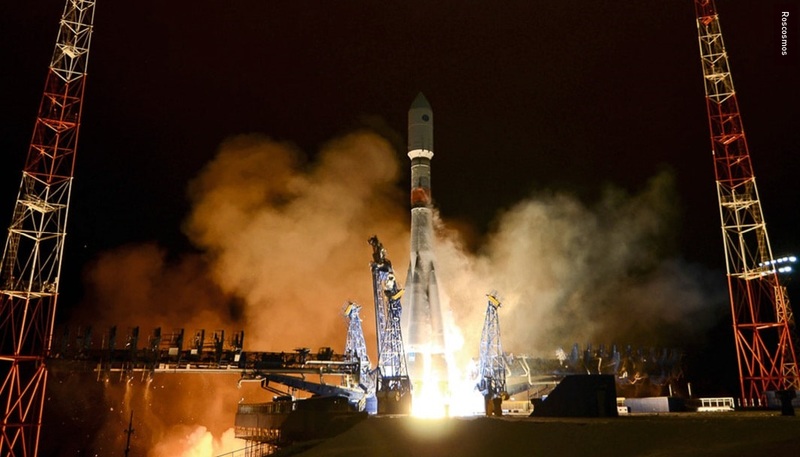 On 24 November 2021, Russia successfully launched a classified military satellite, believed to be part of the Kremlin’s early warning anti-missile system.
On 24 November 2021, Russia successfully launched a classified military satellite, believed to be part of the Kremlin’s early warning anti-missile system.
Coming out of the shadows
A civilian, non-military motivation still guides the romantics, enthusiasts, amateur astronomers, scientists and aspiring astronauts
Military space was largely hidden away, explained away or ignored. In 1959, the United States first attempted to shoot down a satellite, its own Explorer 6 and missed, but this was little advertised at the time. In 1964, Project West Ford put 480 million copper needles into orbit (64 clusters are still there). Explained as a communications test, it was actually part of an attempt to create an artificial ionosphere above the Earth, to improve military communications.
The enormous Starfish Prime nuclear explosion over Hawaii (July 1962), so bright that people could read the newspaper outside at night by its light, knocked out both the famous Telstar communications satellite and the first British satellite, Ariel, but few talked about it. The Manned Orbiting Laboratory (MOL) project, cancelled in 1969, was touted as an early spacelab, not the military observation post that it was intended to be.
The concealment of military space was well matched on the Soviet side. Ever more military programmes were assigned Cosmos numbers, from photo-reconnaissance to electronic intelligence to communications. Where the Soviet Union went a step further was in its development of a manoeuvrable satellite interceptor, Polyot, which would explode at point of interception; the Fractional Orbital Bombardment System (FOBS) of single-orbit nuclear weapons testing; and exploding photo-reconnaissance satellites after their use. This expanded military space by putting weapons into orbit and by beginning what we now call the debris problem. A military space station, Almaz, was concealed within the Salyut space station programme and it was only afterwards that we learned that cannon was installed to fend off prospective attackers.
By the 1980s, though, the concealment of military space within ‘civilian’ space by all the space powers became less and less feasible or credible. On the American side, the growth of military programmes was more than evident to the expanding population of space trackers, amateurs and enthusiasts. The key moment that military space became public was the space shuttle, whose operational capabilities and features were negotiated between the US Air Force, NASA, the Congress and the White House. It even had its own dedicated west coast military base, Vandenberg Air Force Base. Not long afterwards, President Ronald Reagan’s Strategic Defence Initiative (SDI) marked the formal weaponization of military space.
Although the shuttle never flew from the west coast, there were military payloads or dedicated military shuttle missions, estimated at eleven from 1982-92. It was practice to identify the crew and broadcast the launch from countdown to main engine cut-off; and the final stages of the landing, but there was blackout in between. What is most surprising, though, is that the normally persistent corps of space sleuths showed almost no interest in drawing attention to them, nor finding out more about these missions. Only a few reported on its successor, the X-37 spaceplane.
In effect, the secret shuttle flights marked the normalisation of military space. Romantic adventure that spaceflight might be, those in authority reached the view - accurately it seems - that there was now a public acceptance of the legitimacy of military space.
So where are the world’s military space programmes now? The big military space spender is the United States (€21.6bn); followed far behind by China (€2.5 billion); Russia, €1.4 billion; Japan, €0.91 billion; France €749 million (Policy Exchange). Although this is little realised, the US military budget has typically been higher than that of NASA. So, in military space, the US outspends the rest of the world combined.
 Films like The Right Stuff (Warner Brothers, 1983) unmistakeably reflected the US government and media portrayal of early space as ‘peaceful purposes’.
Films like The Right Stuff (Warner Brothers, 1983) unmistakeably reflected the US government and media portrayal of early space as ‘peaceful purposes’.
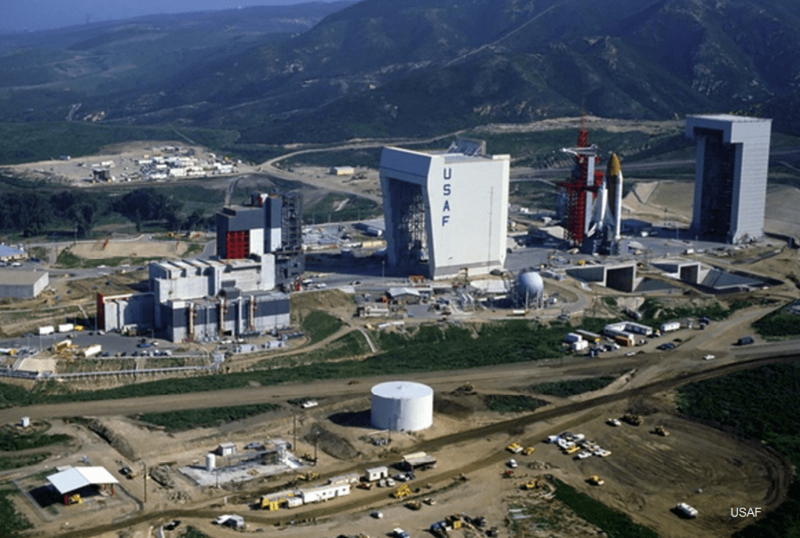 The Space Shuttle had its own dedicated west coast military base, Vandenberg Air Force Base.
The Space Shuttle had its own dedicated west coast military base, Vandenberg Air Force Base.
Full spectrum
There has been a normalisation of the narrative, starting with Star Wars in 1980s, but now most evident with dedicated ‘Space Forces’
In desegregating military space, it is helpful to look at those countries that have full-spectrum military programmes; those that are largely military; those that have limited military programmes and those that are entirely civilian.
We also need to make distinctions in the difficult area of ‘dual use’ - systems that can be used for both military and civilian purposes. The two original full-spectrum military space powers were the Soviet Union and the United States. ‘Full spectrum’ essentially comprises satellites for:
- Optical photo-reconnaissance, generally focussed on land
- Radar-based reconnaissance, often focussed on naval movements
- Electronic intelligence (elint) and signals intelligence (sigint)
- Military communications
- Missile warning, normally using
infrared detectors.
In the 1980s, for example, there were almost weekly launches by the USSR of one satellite or another in the Cosmos series to cover this spectrum. They were paralleled by the United States which had lower launch rates but fielded more technically advanced systems sooner.
This situation in which the two super-powers matched one another did not survive into the 1990s. The economic chaos of the post-Soviet period reduced the Russian system to such a low level that there were periods when it no longer had certain types of military satellites in orbit at all - it was both ‘blind’ and ‘deaf’. Although capacity was re-built by President Putin, it is still far short of the Soviet-period. Instead, a new full-spectrum superpower emerged, China, with its own range of satellites to cover these core capacities, starting with the Yaogan series. The proportion of Chinese satellites used for military purposes is estimated at 21 percent.
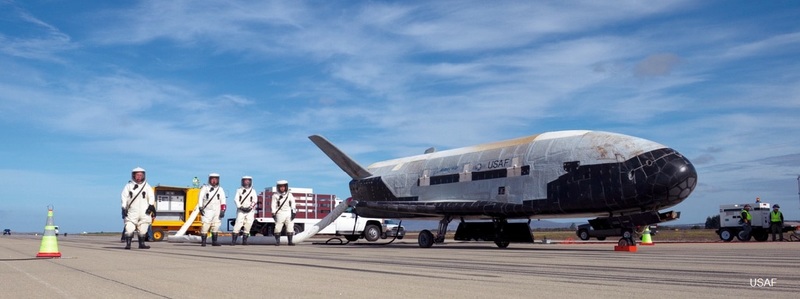 The U.S. Space Force has a mini-fleet of two robotic X-37B space planes, which have been flying secret missions since 2010.
The U.S. Space Force has a mini-fleet of two robotic X-37B space planes, which have been flying secret missions since 2010.
Only one country has a largely military space programme: Israel. This is hardly surprising, given its location and its inability to gain military observation intelligence on its neighbours any other way, with 12 Offeq satellites launched from 1988.
The European Space Agency (ESA) is a civilian body. Several of its member states though, have military space projects unconnected to ESA, mainly in optical and radar observations and military communications (e.g., Britain’s Skynet). The principal countries with military satellites are France, Germany, Italy, Spain and Britain, but none aspires to full-spectrum operations. Their membership of NATO and its accompanying inter-operability means that they would likely have access to the range of American systems and each other’s. Ironically, some of these satellites were orbited by Russian launchers both from their military base at Plesetsk and the now-abandoned Soyuz base in Kourou in the European Union - to spy on Russia!
 The sky over Maui 45-90 seconds after project Starfish Prime’s suborbital nuclear detonation 400 km (250 mi) above the Pacific Ocean. The effect of the explosion was so bright that people could read the newspaper outside at night by its light.
The sky over Maui 45-90 seconds after project Starfish Prime’s suborbital nuclear detonation 400 km (250 mi) above the Pacific Ocean. The effect of the explosion was so bright that people could read the newspaper outside at night by its light.
The new country on the military block is Japan. The post-war constitution, confirmed by Japan’s Diet in 1969, ruled that space was exclusively for peaceful purposes, so Japan developed a successful programme of space science, exploration, applications and human spaceflight accordingly. This changed following the overflight of a Taepo Dong missile from the Democratic People’s Republic of Korea (DPRK) in 1998, after which Japan began a substantial investment in what were called Intelligence Gathering Satellites (IGS), pairs of optical and radar satellites.
There is there is merit in finding ways of de-escalation, especially through continuing legal work of the United Nations to keep weapons out of space
Under reforming minister Takeo Kawamura, navigation and communications satellites were added, with military security identified as the top priority of the space programme. The Liberal Democratic Party prioritised the military programme, with China and Russia added to the list of regional enemies. The shift in priorities came at the expense of the hitherto all-civil space programme. Japan, which had been first to the Moon after the USSR and USA (1990) and which won the ‘great Asian space race’ against China and India (2007), effectively abandoned its lunar programme for the time being.
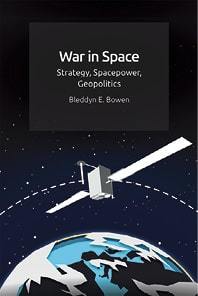 The rapidly expanding literature on the militarisation of space includes Bleddyn Bowen’s War in Space: Strategy, Spacepower, Geopolitics, which applies strategic theory to outer space and draws out the implications for international relations
The rapidly expanding literature on the militarisation of space includes Bleddyn Bowen’s War in Space: Strategy, Spacepower, Geopolitics, which applies strategic theory to outer space and draws out the implications for international relations
Likewise, India’s space programme, as inspired by Vikram Sarabhai, was devoted to economic and social purposes such as Earth observation, weather warning and communications. Over time, India broadened its capacity into missions to the Moon (2007, 2021) and Mars (2014), but it was not until 2019 that the Indian space programme developed an explicit military dimension by shooting down one of its own satellites, Microsat R.
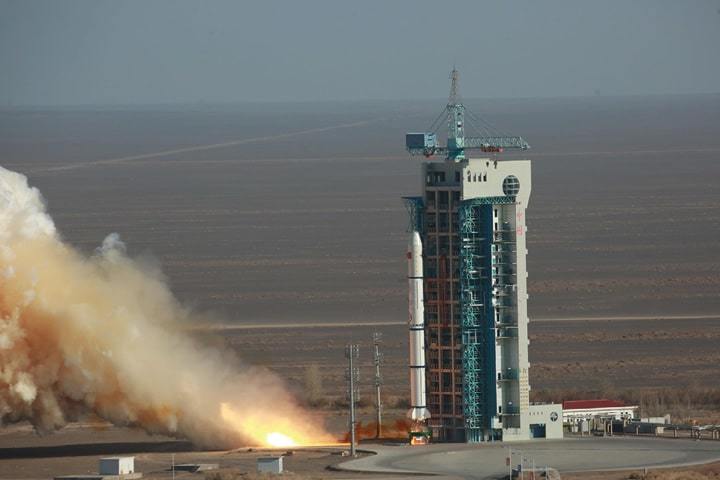 China’s sixth orbital launch of 2022 took place on 17 March, carrying a classified Yaogan 34 satellite into orbit. Chinese state media reported that the new Yaogan satellites will be used to provide information services such as land census, urban planning, crop yield estimation and disaster prevention and reduction. The classified nature of the Yaogan missions lead Western analysts to believe the series is military in nature, providing a range of reconnaissance capabilities.
China’s sixth orbital launch of 2022 took place on 17 March, carrying a classified Yaogan 34 satellite into orbit. Chinese state media reported that the new Yaogan satellites will be used to provide information services such as land census, urban planning, crop yield estimation and disaster prevention and reduction. The classified nature of the Yaogan missions lead Western analysts to believe the series is military in nature, providing a range of reconnaissance capabilities.
Dual use in practice
‘Dual-use’ presents a problem in the analysis of military space - satellites that could be used for military and/or civilian purposes, principally for navigation. Although for most people, navigation satellites are principally used in cars, taxis and walking the great outdoors, they are universally used for aircraft and ships - and can also be used for targeting missile and drone attacks.
First into the field was the Global Positioning System (GPS), the Americans building in a system that would enable only the military to access its highest-grade positioning, a model followed by others. A similar model was developed by Russia (GLONASS), China (Beidou) and India, the Indian Regional Navigational Satellite System (IRNSS).
Europe developed a technical workaround to circumvent the dual use problem by part-funding its system, Galileo, through the European Union, so that the military of its member states could access the military precision level by virtue of their EU membership, not ESA, an arrangement that caused a headache for Britain when it left the Union.
In effect, military space comprises three full-spectrum powers (US, Russia, China); countries with a significant military element (Japan) as well as individual European countries outside the ESA framework (France, Germany, Spain, Italy, Britain); one country largely military (Israel); and countries or groups of countries with dual-use systems, typically navigation. It is not a static picture, with some countries gaining in capacity (e.g., China, Japan) and others declining (Russia), but the key contours of military space are well-known.
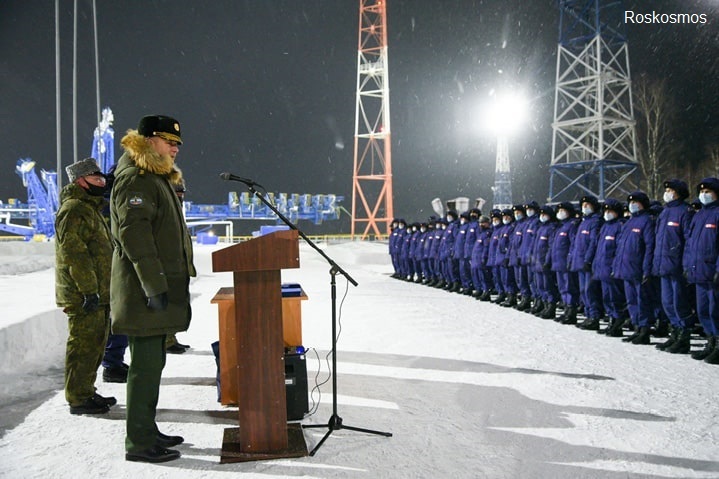 GLONASS launch, Plesetsk
GLONASS launch, Plesetsk
This is not the case though, for space weapons, because they are the most destabilising and unpredictable element in the picture. Again, they are nothing new, as the earlier history illustrated. Such incidents have become more frequent and blatant in recent years, with the Chinese shoot down of Feng Yun 1-03 (2007); the American shoot down of NROL 21 (2008); the Indian test (2019) and then the Russian Nudol explosion (2021). Moreover, they make significant contributions to the problem of debris, which can threaten the crews of the International Space Station and the Chinese Tiangong.
A new dimension is what are sometimes called ‘inspector’ satellites, which may follow, inspect and potentially disable satellites on the other side. Although they have their origins in the 1960s, they have now been re-tested by several countries, for example Cosmos 2523 on the Russian side.
Again, some fall within a dual-use category, for such manoeuvres can also be used harmlessly to capture and tug away derelict satellites to graveyard orbits, as China demonstrated in early 2022 when Shijian 21 removed an old Beidou navigation satellite.
By the 1980s, though, the concealment of military space within ‘civilian’ space by all the space powers became less and less feasible or credible
A more recent development is trailing other countries to scoop up the communications of military communications satellites in 24-hour orbit. This seems to have been pioneered in 1990 by the American shuttle-launched Prowler, since imitated by the Russian Luch Olymp (2014).
In conclusion, it is not clear if the actual nature of military space has changed much since the opening days of the space era. There were irresponsible actions then (Project West Ford, Explorer 6, Starfish Prime, FOBS) as there are now (Feng Yun 1-03, NROL, Microsat, Nudol, hypersonic orbits). Military capacity has grown and extended to new nations, most dramatically China and Japan.
![]() Military tracking station.
Military tracking station.
There has been a normalisation of the narrative, starting with Star Wars in 1980s, but now most evident with dedicated ‘Space Forces’. Cool-headed objective analysis to interpret military activity in orbit, of the type carried out by the late Phil Clark in Britain, now most evident in the invaluable research of Dwayne Day in the United States and by Bart Hendrickx in Belgium, tends to be outgunned by commentaries higher on suspicion and hyperbole.
In the most challenging international situation for a generation, there is there is merit in finding ways of de-escalation, especially through continuing legal work of the United Nations to keep weapons out of space.
About the author
Brian Harvey is a specialist space writer and broadcaster based in Dublin, Ireland. He is the author of China in Space - the Great Leap (2nd edition) (Praxis/Springer, 2019) and European-Russian Cooperation in Space - from de Gaulle to ExoMars (Praxis/Springer, 2021).














